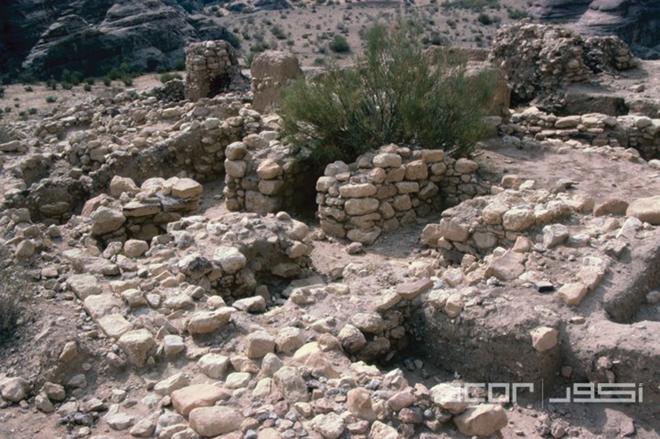You are here
Jordan River ‘never border or obstacle’ between west, east banks — scholar
By Saeb Rawashdeh - Jun 06,2017 - Last updated at Jun 06,2017

A statue unearthed in Ain Ghazal (Photo courtesy of Muawiyah Ibrahim)
AMMAN — The Jordan River was “never the border or an obstacle” between the west and east banks and the population and goods freely crossed, according to a Jordanian scholar.
From Natufian period — around 12,500 to 9,500 BC — there were strong ties between the east and west sides of the Jordan River, and archaeologists found large number of Natufian sites on both banks and as far as in the eastern desert, Professor Emeritus Muawiyah Ibrahim from University of Yarmouk in Irbid stated.
“The best so far is the site Seil Al Himmeh, just north of Tabaqat Fahil [Pella], where the large number of basalt and flint tools was found dating 12,000 BC; very specific find is the sickle made of animal bones and two rows of flint knives,’’ Ibrahim says.
These finds are on display at the Museum of Jordan Heritage at Yarmouq University in Irbid.
This period was followed by Pre-Pottery Neolithic period and many sites of this era were excavated on both sides of the Jordan River, Ibrahim noted, adding that the daily life, burial practices and objects show that there were strong ties between people living in Jericho, south and north of Pella, in Ain Ghazal, in Wadi Mujib (Safie) and in all Pre-Pottery Neolithic sites in Petra (Beidha, Basta and Baja).
“The Pre-Pottery Neolithic period was followed by village farming community, which indicated the rapid increase in population of the entire region,” he told The Jordan Times in a recent interview.
“In Jordan we have Tuleilat Ghassul on the northeastern corner of the Dead Sea, Tell Abu Hamid and Pella in the Jordan Valley, but also sites like Sahab, Irbid and others in eastern Jordanian plateau,” the expert added.
The archaeologist said that large settlements were excavated from that period which showed the fast development of agricultural products, while the fauna at these sites showed that cattle life was developed in large scale.
“This kind of large village farming communities contributed to the establishment of the organised life around the 4th millennium BC and it was the time of the first fortified settlements such as Khirbet Ez Zeraqoun, which indicated the beginning of organised city states and villages,” the professor noted.
Ain Ghazal was one of the largest settlements at the Pre-Pottery Neolithic sites, while Safie was another populous site from that era, he said, stressing that after the end of the Early Bronze Age, there was a gap in occupation or intermediate period, which included the territory of the whole Near East.
“After this intermediate period major political and military powers took place in Mesopotamia and Egypt,” the archaeologist claimed.
In Egypt Hyksos became the rulers and their reign began in the 18th century BC and lasted until the mid-16th century BC.
“We don’t know about their origin but in literature they are known as Asiatic people,” Ibrahim explained, noting that the entire region of Bilad Al Sham fell under the rule of Hyksos who develop the new system of fortifications known as glacis that consisted of forts supported by sloping material of lime and earth to prevent invaders from penetrating the fortification.
“We have good examples in Jordan including Amman, Tell Safut [between Sweileh-Baqaa] and Tell Irbid,” he highlighted.
Sahab is also an example and Tell Al Hammam in south Jordan Valley, the scholar added.
When the New Kingdom was established, after the end of Hyksos’ rule, the area of Jordan and Palestine became under complete Egyptian control: “It was to the extent that all town rulers in Palestine and Jordan were appointed by pharaoh.”
“It is possible that Sahab and Pella were administrative posts of Egypt east of the Jordan River,” Ibrahim pointed out.
“During this period we have written sources for the first time dating from the 14th century BC called Amarna Letter named after Tell Amarna in south Egypt where 400 cuneiform tablets were found and some were found in Palestinian towns as well as in Pella,” he said.
“Egyptian court officials had to learn Babylonian to be able to correspond with town rulers in Bilad Al Sham,” explained Ibrahim, adding that in this period Palestine and Jordan had strong ties with Aegean islands during the late Bronze Age as the large number of Mycenaean and Cypriot vessels were found.
“One of important excavation sites where many objects were unearthed was Marka Shamalia while Sahab was the major fortified site of that period,” Ibrahim highlighted.
Related Articles
AMMAN — Located some 500 metres from the old Amman-Jerash road, Tell Abu Suwwan represents one of the Neolithic mega sites whose occupation
AMMAN — Evidence of human occupation in wadis from the Jordanian central massive goes back to the Palaeolithic period as it was evidenced in
AMMAN — The Neolithic period is rich in archaeological remains that show most of the fundamental developments in human history, noted a Jord

















